ISSN ONLINE(2278-8875) PRINT (2320-3765)
ISSN ONLINE(2278-8875) PRINT (2320-3765)
M.Veereshappa1, Dr.S.N.Mulgi2
|
| Related article at Pubmed, Scholar Google |
Visit for more related articles at International Journal of Advanced Research in Electrical, Electronics and Instrumentation Engineering
A low profile rectangular monopole microstrip antenna is proposed for notch band operation. The antenna has a simple structure consists of a L- slot loaded rectangular radiating patch of 2.34 X 3.04 cm2 with truncated corners fabricated using low cost substrate material FR4. The proposed antenna uses top and bottom ground planes. The effect of L-slot on the patch is studied for notch band variation. The antenna operates for 31.75 % and 40.87 % of bandwidth also gives highest gain of 11.07 dB. In both the bands antenna gives ominidirectional radiation characteristics. The proposed antennas may find application in microwave communication systems operating between 7 to 16 GHz of frequencies.
Keywords |
| corner truncated, microstrip antenna, monopole, slot, ominidirectional |
INTRODUCTION |
| Emerging trends in microwave communication systems often require antennas of compact size, simple in design, thin profile, light weight, low cost, planar configuration and easy fabrication. The microstrip antenna is the better choice for these requirements. The design and development of microstrip antenna operating for desired frequency bands and rejecting unused band is the better choice for specific application in microwave communication. Number of investigations have been reported in the literature for the design and development of notch band operation [3-11]. Most of the antennas presented in the literature are either complex in their structure or bigger in size and hence require carful manufacturing procedure than that of the regular microstrip antenna for practical applications. In this study we have demonstrated a simple technique to achieve a notch band operation of rectangular monopole antenna. |
DESIGN OF ANTENNA GEOMETRY |
| The art work of the proposed antenna is sketched by using computer software Auto-CAD to achieve better accuracy and is fabricated on low cost FR4-epoxy substrate material of thickness of h = 0.16 cm and permittivity r = 4.4. |
| Figure 1 shows the top view geometry of corner truncated L-slot rectangular monopole microstrip antenna (CTLSRMA). In Fig.1 the area of the substrate is L ïÃâô W cm. On the top surface of the substrate a ground plane of height which is equal to the length of microstripline feed Lf is used on either sides of the microstripline with a gap of 0.1 cm. On the bottom of the substrate a continuous ground copper layer of height Lf is used below the microstripline. The CTLSRMA is designed for 3 GHz of frequency using the equations available for the design of conventional rectangular microstrip antenna in the literature [2]. The length and width of the rectangular patch are Lp and Wp respectively. The feed arrangement consists of quarter wave transformer of length Lt and width Wt which is connected as a matching network between the patch and the microstripline feed of length Lf and width Wf. A semi miniature-A (SMA) connector is used at the tip of the microstripline feed for feeding the microwave power. In Fig.1 four corners of the rectangular patch is truncated with the vertical and horizontal length of Tx and Ty respectively. Further L-slot is loaded on the radiating patch with vertical length, horizontal length and width of slot is X, Y and Z respectively. The L-slot is placed at a distance 0.2 cm from the non radiating side Lp of the patch. |
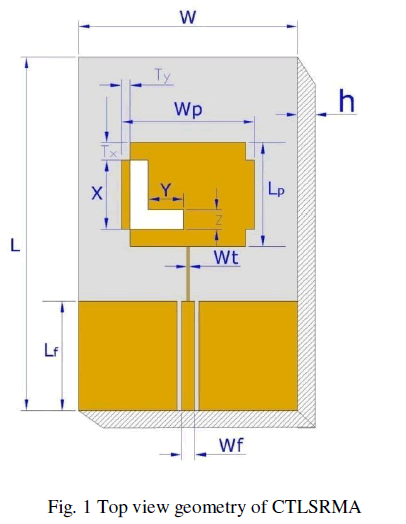 |
| Figure 2 shows the geometry of corner truncated shifted L slot rectangular monopole microstrip antenna (CTSLSRMA). In this figure the location of L-slot is shifted, which is placed at a distance of 0.4 cm from the non radiating edge of the patch. The other geometry of Fig. 2 remains same as that of Fig.1. The design parameters of the proposed antenna are as shown in Table 1. |
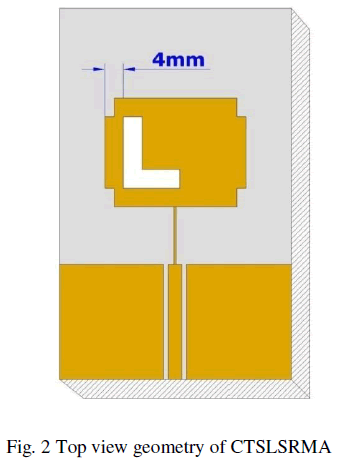 |
 |
EXPERIMENTAL RESULTS |
| The antenna bandwidth over return loss less than -10 dB is tested experimentally on Vector Network Analyzer (Rohde & Schwarz, Germany make ZVK model 1127.8651). The variation of return loss verses frequency of CTLSRMA is as shown in Fig. 3. From this graph the experimental bandwidth (BW) is calculated using the equations, |
 |
| were, f1 and f2 are the lower and upper cut of frequencies of the band respectively when its return loss reaches – 10 dB and fc is the center frequency of the operating band. From this figure, it is found that, the antenna operates between 7 to 16 GHz and gives two resonant modes at f1 and f2, i.e. at 7.76, and 13.84 GHz. The magnitude of experimental -10 dB bandwidth measured for BW1 and BW2 by using the equation (1) is found to be 2.71 GHz (31.75 %) and 5.43 GHz (40.87 %) respectively. The notch band of 0.68 GHz (9.89-10.57) appears between BW1 and BW2. The dual band response obtained is due to different surface currents on the patch. The fundamental resonant frequency mode shifts from 3 GHz designed frequency to 7.76 GHz due to the coupling effect of microstripline feed and top ground plane of CTLSRMA. |
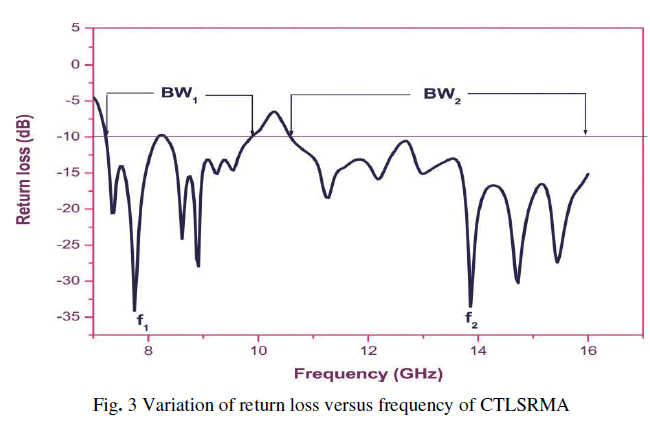 |
| Figure 4 shows the variation of return loss verses frequency of CTSLSRMA. It is seen that, the antenna operates for two bands of frequencies BW3 and BW4. The magnitude of these operating bands measured at BW3 to BW4 is found to be 2.86 GHz (32.98 %), and 5.54 GHz (41.87 %) respectively. Further from Fig.4 it is clear that, the CTSLSRMA is capable of widening its operating bands when compared to the operating bands of BW1 and BW2 CTLSRMA. The notch band (10.10-10.46) appears between BW3 and BW4 which is reduced in this case by 3.50 %. Hence the location of L-slot on the patch is effective in controlling the notch band operation of an antenna |
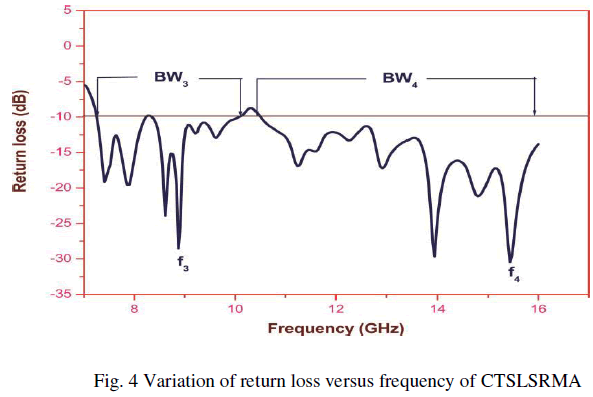 |
| The gain of the proposed antennas is measured by absolute gain method. The power transmitted ‘Pt’ by pyramidal horn antenna and power received ‘Pr’ by antenna under test (AUT) are measured independently. With the help of these experimental data, the gain (G) dB of AUT is calculated by using the formula, |
 |
| where, Gt is the gain of the pyramidal horn antenna and R is the distance between the transmitting antenna and the AUT. Using equation (2), the peak gain of CTLSRMA and CTSLSRMA are found to be10.73 dB, 7 .32 dB in BW1 and BW2 and 11.07 dB, 10.27 dB in BW3 and BW4 respectively. From this it evident that the CTSLSRMA is capable of giving lager gains when compared to the gain of CTLSRMA. |
| The co-polar and cross-polar radiation pattern of CTLSRMA and CTSLSRMA is measured in their operating bands. The typical radiation patterns measured at 4.70 GHz and 4.87 GHz are as shown in Fig 5 to 6 respectively. The obtained patterns are ominidirectional in nature. |
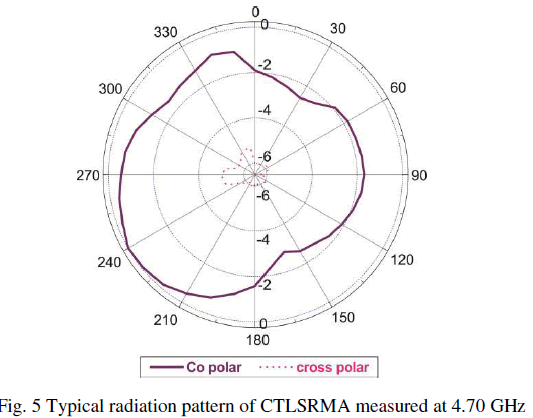 |
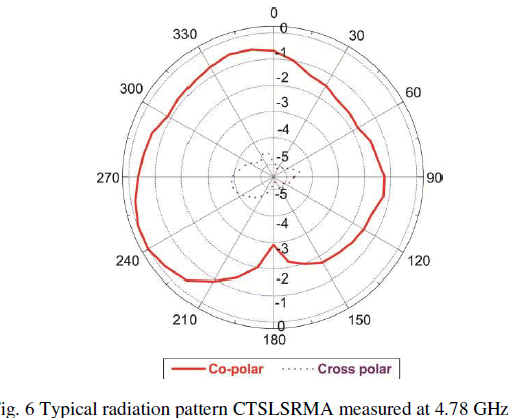 |
CONCLUSION |
| From the detailed experimental study, it is concluded that, the CTLSRMA with microstripline feed has been designed for notch band operation. The antenna operates for two bands of frequencies in the range of 7 to 16 GHz. If the location of L-slot is shifted, the antenna operates again for dual bands but reduces the magnitude of notch band causing enhancement for the operating bands. The CTSLSRMA also enhances the gain when compared to the gain of CTLSRMA. In both the cases the antenna gives ominidirectional radiation characteristics. The proposed antennas are simple in their design and fabrication and they use low cost substrate material. With these features the proposed antennas may find application in microwave communication systems operating in the frequency range of 7 to 16 GHz. |
ACKNOWLEDGEMENT |
| The authors would like to thank Dept. of Sc. & Tech. (DST), Govt. of India. New Delhi, for sanctioning Vector Network Analyzer to this Department under FIST project. The authors also would like to thank the authorities of Aeronautical Development Establishment (ADE), DRDO Bangalore for providing their laboratory facility to make antenna measurements on Vector Network Analyzer. |
References |
|